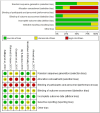Effects of core stability exercises on balance ability of children and adolescents with intellectual disabilities: A systematic review and meta-analysis
- PMID: 39700130
- PMCID: PMC11658597
- DOI: 10.1371/journal.pone.0314664
Effects of core stability exercises on balance ability of children and adolescents with intellectual disabilities: A systematic review and meta-analysis
Abstract
Background: Children and adolescents with intellectual disabilities (IDs) are at risk of falls due to balance problems. One way to palliate balance deficits among this population is via core stability exercises. However, comprehensive studies that examine the effectiveness of core stability exercises in improving balance in this target population are lacking.
Objective: This study aims to summarise and quantify the effectiveness of core stability exercises in improving the balance of this target population.
Methods: This study followed PRISMA principles and conducted comprehensive searches in six academic databases (PubMed, Web of Science, Medline, Embase, Scopus, and the Cochrane Library) up to June 2023. The inclusion criteria were established via the PICOS framework. The risk of bias was assessed with the Cochrane risk-of-bias tool, and the certainty of the evidence was assessed via the GRADE approach. The meta-analysis was performed via RevMan 5.4, and for data that could not be pooled via meta-analysis, we used a narrative description of the results of each study.
Results: Six studies of 1078 subjects were included. The findings revealed that core stability exercises improved the dynamic balance of children and adolescents with ID but had no significant effect on static (Hedges' g = 1.32, 95% CI [-0.41 to 3.06]) or static‒dynamic (Hedges' g = 1.35, 95% CI [-0.02 to 2.73]) balance compared with the control groups. The quality of evidence based on the GRADE approach was very low.
Conclusions: Core stability exercises may improve dynamic balance in children and adolescents with ID, but given the scarcity of studies included, definitive conclusions cannot yet be drawn. Although pooled analyses also highlighted improvements in static and static-dynamic balance with large effect sizes over active control groups, the results were not statistically significant and should be interpreted with caution given the wide confidence intervals. The heterogeneity among the identified studies and the limited number of eligible studies may reduce the reliability of the results, but these findings emphasise the need for additional research in this domain.
Copyright: © 2024 Zhou et al. This is an open access article distributed under the terms of the Creative Commons Attribution License, which permits unrestricted use, distribution, and reproduction in any medium, provided the original author and source are credited.
Conflict of interest statement
The authors declare that there is no conflict of interest.
Figures
Similar articles
-
Exercise interventions to improve balance for young people with intellectual disabilities: a systematic review and meta-analysis.Dev Med Child Neurol. 2019 Apr;61(4):406-418. doi: 10.1111/dmcn.14023. Epub 2018 Sep 19. Dev Med Child Neurol. 2019. PMID: 30230530
-
Do Exercise Interventions Improve Balance for Children and Adolescents With Down Syndrome? A Systematic Review.Phys Ther. 2019 May 1;99(5):507-518. doi: 10.1093/ptj/pzz012. Phys Ther. 2019. PMID: 31089706
-
Effects and Dose-Response Relationship of Balance Training on Balance Performance in Youth: A Systematic Review and Meta-Analysis.Sports Med. 2018 Sep;48(9):2067-2089. doi: 10.1007/s40279-018-0926-0. Sports Med. 2018. PMID: 29736728
-
Exercise for preventing falls in older people living in the community.Cochrane Database Syst Rev. 2019 Jan 31;1(1):CD012424. doi: 10.1002/14651858.CD012424.pub2. Cochrane Database Syst Rev. 2019. PMID: 30703272 Free PMC article.
-
The effectiveness of digital technology-based Otago Exercise Program on balance ability, muscle strength and fall efficacy in the elderly: a systematic review and meta-analysis.BMC Public Health. 2025 Jan 7;25(1):71. doi: 10.1186/s12889-024-21251-9. BMC Public Health. 2025. PMID: 39773392 Free PMC article.
Cited by
-
Effects of Core Stability Training on Balance, Standing, and Gait in Children with Mild Cerebral Palsy: A Randomized Controlled Trial.Healthcare (Basel). 2025 May 29;13(11):1296. doi: 10.3390/healthcare13111296. Healthcare (Basel). 2025. PMID: 40508909 Free PMC article.
References
-
- Melo RS, Tavares-Netto AR, Delgado A, Wiesiolek CC, Ferraz KM, Belian RB. Does the practice of sports or recreational activities improve the balance and gait of children and adolescents with sensorineural hearing loss? A systematic review. Gait Posture. 2020; 77: 144–55. doi: 10.1016/j.gaitpost.2020.02.001 . - DOI - PubMed
Publication types
MeSH terms
LinkOut - more resources
Full Text Sources





